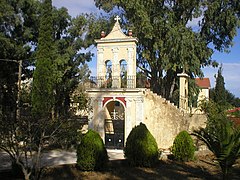Atheras (Kefalonia)
|
Local community Atheras Τοπική Κοινότητα Αθέρος (Αθέρας) |
||
|---|---|---|
|
|
||
| Basic data | ||
| Country |
|
|
| region | Ionian islands | |
| Regional district | Kafalonia | |
| local community | Kefalonia | |
| Parish | Paliki | |
| Geographic coordinates | 38 ° 19 ′ N , 20 ° 25 ′ E | |
| Height above d. M. |
280 m (average) |
|
| surface | 19.363 km² | |
| Residents | 129 (2011) | |
| Population density | 6.66 km² | |
| Local division | 1 settlement | |
Atheras (formerly also: Ather or Aether, Greek Αθέρας ( m. Sg. ) Ital. Aterra ) is a village with the status of a local community in the municipality of Lixouri on Kefalonia with 129 inhabitants. Atheras is located near the northwestern tip of Kefalonia, south of the beach of the same name ( Porto Atheras , Greek Πόρτο Αθέρας ), which became known because the Norman king Robert Guiskard was theredied of fever on July 17, 1085 when he docked to conquer the island. The bay forms an almost closed port with the tiny island of Averonissi (or Nisaki) in front of the opening.
The area around the place is hardly inhabited, but is used for goat and sheep breeding, as well as a few smaller olive tree plantations. The place is accessible via a junction of the Lixouri-Livadi road, which ends at the beach after 10 kilometers.
history
The English author Robert Bittlestone argues in his book Odysseus Unbound that the place Atheras belonged to the ancient kingdom of Odysseus and that the beach of Atheras was Phorcys Bay, where Odysseus ended up stranded. He is also of the opinion that Eumaeus , a friend of Odysseus, ran his pig farm near the present village cemetery.
The latest geological studies by the British Geological Society corroborate the thesis that today's western peninsula of Kefalonia, Paliki, was separated from Kefalonia in the Bronze Age by the isthmus of Thimia (which the Greek geographer Strabo already described), which was later tectonically raised and buried by falling rocks : Bittlestone locates the homeland of Odysseus in Paliki instead of on the island of Ithaca .
Two tectonic plates collide under Kefalonia, the European and the Aegean . In 1953, a large part of the village was destroyed in the devastating earthquake, which with a magnitude of 7.2 raised large parts of Kefalonia by 60 centimeters and caused large parts of the population to move away.
In the recent past Atheras was struck by a forest fire that burned many pieces of forest around the village. However, nature has now recovered from the consequences.
Attractions
- the church (long nave basilica) of St. Paraskevi, which celebrates on the day of St. Spiridon, July 26th
- the beach with the former monastery (the latter is privately owned, so entry is prohibited)
- a Venetian olive press
See also
Individual evidence
- ↑ Results of the 2011 census at the National Statistical Service of Greece (ΕΛ.ΣΤΑΤ) ( Memento from June 27, 2015 in the Internet Archive ) (Excel document, 2.6 MB)
- ↑ Testing Classical Enigmas ( Memento from July 28, 2009 in the Internet Archive ) (English)




